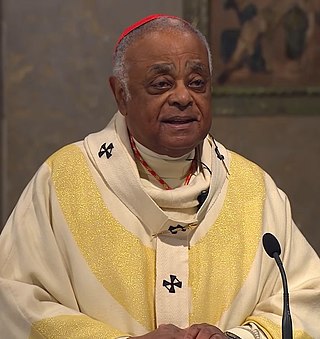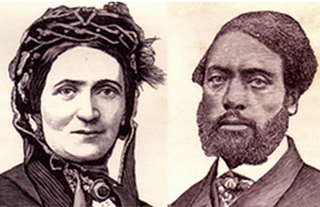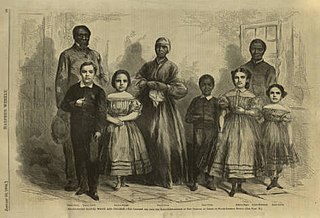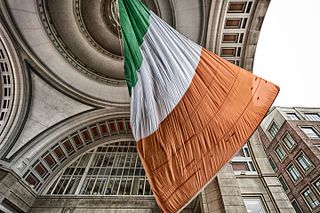
Martín de Porres Velázquez was a Peruvian lay brother of the Dominican Order who was beatified in 1837 by Pope Gregory XVI and canonized in 1962 by Pope John XXIII. He is the patron saint of mixed-race people, barbers, innkeepers, public health workers, all those seeking racial harmony, and animals.

In the context of the history of slavery in the Americas, free people of color were primarily people of mixed African, European, and Native American descent who were not enslaved. However, the term also applied to people born free who were primarily of black African descent with little mixture. They were a distinct group of free people of color in the French colonies, including Louisiana and in settlements on Caribbean islands, such as Saint-Domingue (Haiti), St. Lucia, Dominica, Guadeloupe, and Martinique. In these territories and major cities, particularly New Orleans, and those cities held by the Spanish, a substantial third class of primarily mixed-race, free people developed. These colonial societies classified mixed-race people in a variety of ways, generally related to visible features and to the proportion of African ancestry. Racial classifications were numerous in Latin America.

James Augustine Healy was an American prelate of the Catholic Church. He was the first known African American to serve as a Catholic priest or bishop. With his predominantly European ancestry, Healy passed for a white man and identified as such.

Patrick Francis Healy was an American Catholic priest and Jesuit who was an influential president of Georgetown University, becoming known as its "second founder". The university's flagship building, Healy Hall, bears his name. Though he considered himself and was largely accepted as White, Healy was posthumously recognized as the first Black American to earn a PhD, as well as the first to enter the Jesuit order and to become the president of a predominantly White university.

Wilton Daniel Gregory is an American prelate of the Catholic Church who has been serving as the archbishop of the Archdiocese of Washington since 2019. Pope Francis elevated him to the rank of cardinal on November 28, 2020. He is the first African-American cardinal.

Ellen Craft (1826–1891) and William Craft were American abolitionists who were born into slavery in Macon, Georgia. They escaped to the Northern United States in December 1848 by traveling by train and steamboat, arriving in Philadelphia on Christmas Day. Ellen crossed the boundaries of race, class, and gender by passing as a white planter with William posing as her servant. Their escape was widely publicized, making them among the most famous fugitive slaves in the United States. Abolitionists featured them in public lectures to gain support in the struggle to end the institution.

John Augustus Tolton, baptized Augustine Tolton, was the first Catholic priest in the United States publicly known to be African American. The name "Augustus" and "Augustine" are both found in historical records. Tolton’s baptismal record lists his name as Augustine and Augustine is also listed on his grave.

Partus sequitur ventrem was a legal doctrine passed in colonial Virginia in 1662 and other English crown colonies in the Americas which defined the legal status of children born there; the doctrine mandated that children of slave mothers would inherit the legal status of their mothers. As such, children of enslaved women would be born into slavery. The legal doctrine of partus sequitur ventrem was derived from Roman civil law, specifically the portions concerning slavery and personal property (chattels), as well as the common law of personal property; analogous legislation existed in other civilizations including Medieval Egypt in Africa and Korea in Asia.

Henriette Díaz DeLille, SSF was a Louisiana Creole of color and Catholic religious sister from New Orleans. She founded the Sisters of the Holy Family in 1836 and served as their first Mother Superior. The sisters are the second-oldest surviving congregation of African-American religious.

Michael Augustine Healy was an American career officer with the United States Revenue Cutter Service, reaching the rank of captain. He has been recognized since the late 20th century as the first man of African-American descent to command a ship of the United States government.
Multiracial Americans or mixed-race Americans are Americans who have mixed ancestry of two or more races. The term may also include Americans of mixed-race ancestry who self-identify with just one group culturally and socially. In the 2020 United States census, 33.8 million individuals or 10.2% of the population, self-identified as multiracial. There is evidence that an accounting by genetic ancestry would produce a higher number.

The Catholic Church in the United States began in the colonial era, but by the mid-1800s, most of the Spanish, French, and Mexican influences had demographically faded in importance, with Protestant Americans moving west and taking over many formerly Catholic regions. Small Catholic pockets remained in Maryland, Alabama, Florida, and Louisiana, but scarcely anywhere else.
In 1800 the Catholics were a small minority everywhere except Maryland. Immigration from Ireland and Germany gave them millions of adherents from the 1840s to the 1880s. Then came millions more from Italy, Poland and Eastern Europe, as well as French Canada. Large numbers of priests and nuns came from Ireland and France. The Irish soon dominated the clergy church, with a great majority of bishops by 1900. As the immigrants arrived new parishes and diocese were created. Rebuffed in efforts to obtain government funds for schools, the Catholics set up a parochial school system largely staffed with nuns. It reached about a third of the children. They also set up colleges. There were few Catholics in the South, apart from Louisiana. However they were well represented in the nation's cities, mill towns and mining centers. Anti-Catholic politics flared briefly in the 1850s, but the Catholic voters surged into the Democratic Party and Irish Catholic politicians played increasingly dominant roles in Democratic machines in Boston, New York, and other major cities. Devotional practices included daily rosary prayers, regular attendance at Sunday Mass, and special roles for devotion to the Blessed Virgin Mary and favorite saints.
Harold Robert Perry, S.V.D. was an African-American clergyman of the Catholic Church. An auxiliary bishop of the Archdiocese of New Orleans for more than twenty years beginning in 1966, he was the first openly African-American Catholic bishop, the second overall, and the first since 1875.

White slave propaganda was a kind of publicity, especially photograph and woodcuts, and also novels, articles, and popular lectures, about slaves who were biracial or white in appearance. Their examples were used during and prior to the American Civil War to further the abolitionist cause and to raise money for the education of former slaves.

People of Irish descent form the largest single ethnic group in Massachusetts, and one of the largest in Boston. Once a Puritan stronghold, Boston changed dramatically in the 19th century with the arrival of immigrants from other parts of the world. The Irish dominated the first wave of newcomers during this period, especially following the Great Irish Famine. Their arrival transformed Boston from an Anglo-Saxon, Protestant city into one that has become progressively more diverse. These people hired Irish as workers and servants, but there was little social interaction. In the 1840s and 50s, the anti-Catholic, anti-immigrant Know Nothing movement targeted Irish Catholics in Boston. In the 1860s, many Irish immigrants fought for the Union in the American Civil War, and that display of patriotism helped to dispel much of the prejudice against them.
Mary Magdalen Healy, CND was an American religious sister of the Congregation of Notre Dame of Montreal in the Roman Catholic Church.

Margaret Mary Jane Healy Murphy, SHSp was an Irish-American Catholic religious sister and early civil rights activist. She known for founding the Sisters of the Holy Spirit and Mary Immaculate, the first order of sisters in the state of Texas, as well as the first free private school for African Americans in San Antonio, Texas.

Black Catholicism or African-American Catholicism comprises the African-American people, beliefs, and practices in the Catholic Church.

















